In the previous article, “Take the 10 Islands of Cabo Verde in your pocket! - Part 1”, you got to know some of the most fantastic places on the islands of Santo Antão, São Vicente, São Nicolau, Sal and Boavista.
Now, in part 2 of the article, the adventure continues with the islands of Maio, Santiago, Fogo, Brava and Santa Luzia.
Maio Island: tranquility and wild beaches
Far from the hustle and bustle of tourism, Maio Island is little explored, full of isolated beaches and wild nature, it is ideal for days of tranquility.
Classified as a World Biosphere Reserve by UNESCO in 2020, the island is just a 20-minute flight (or about 2 hours by ferry) from the capital of Cabo Verde, Praia.
In Maio, time seems to slow down, allowing each visitor to absorb the silence, the sea and the vastness of the natural landscapes. In this destination, you will learn to breathe again, in an environment where calm and simplicity reign.
What to do on the island:
Beaches:
Beach Rotcha:
This long beach of fine white sand is the beating heart of Maio.
With perfect conditions for kitesurfing and windsurfing, Beach Rotcha attracts both water sports enthusiasts and those who prefer to simply relax by the sea.
The expanse of the beach and its translucent blue waters invite visitors to forget about time.
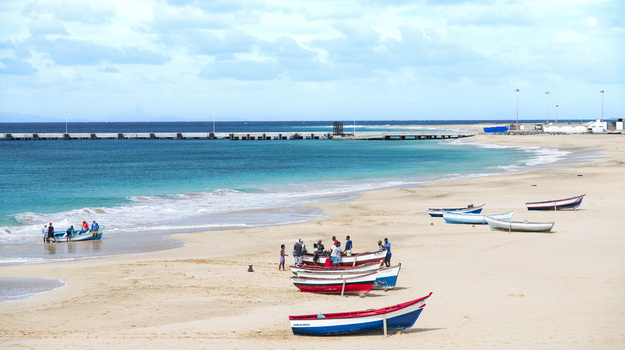 Fishing boats at Praia de Beach Rotcha
Fishing boats at Praia de Beach Rotcha
Morro Beach:
Known for its long stretch of white sand, Morro Beach is an oasis of peace.
Here, the choppy waters are great for amateur fishing with a line and rod. It is also the preferred spot for sea turtles that nest on its sand.
Santana Bay:
Little explored and very well preserved, Santana Bay is home to a beach with the same name. It is one of the wildest on the island of Maio, ideal for long walks by the sea and observation of the local fauna.
The currents are quite strong and for this reason swimming is not recommended. However, the isolation makes this beach special for those looking for a moment of introspection.
Nature and Mountains:
Perimeter Forest (Calheta):
This forested area is largely made up of acacia trees that provide shade, making it a great place for walks.
The silence of the forest and the simplicity of the environment are great for recharging your batteries.
Morrinho Dunes:
In Morrinho, the dunes can reach 15 meters. This is a place that provides stunning views of the island and the sea.
While walking, visitors can enjoy the contrast between the blue of the ocean and the golden sands, as well as feel the gentle breeze that blows across the island. At night, the Morrinho Dunes are one of the best places in Cabo Verde to see the stars.
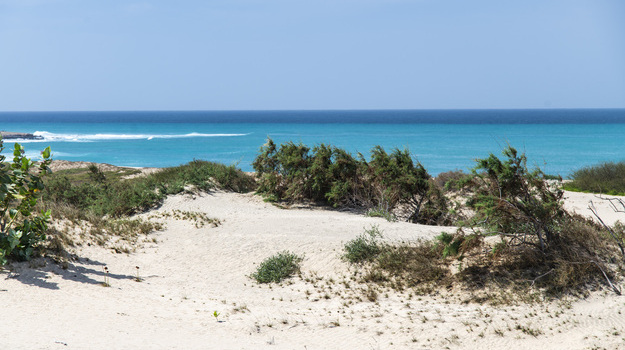 Morrinho Dunes
Morrinho Dunes
Porto Inglês Salt Flats:
The Porto Inglês Salt Flats offer a unique landscape, especially at sunset, when the waters reflect orange and pink tones.
This setting is one of the most photographed places on the island, providing a glimpse of the ancient salt extraction traditions that were part of the local economy.
As a suggestion, visit the Porto Inglês Salt Flats Interpretive Center, a space that showcases and shares the island's tangible, intangible and natural heritage.
Towns and Villages:
Porto Inglês Village:
The capital of the island, Porto Inglês, is a historic town with colonial buildings and a welcoming atmosphere.
The quiet streets and slow pace of life invite visitors to explore every corner, to experience the authenticity of the local culture and the hospitality of the inhabitants.
Calheta:
This peaceful town preserves the local traditions of Maio Island and is known for its beautiful beaches.
In Calheta, it is easy to feel part of the community, with fishermen returning from their fishing and artisans working on traditional pieces.
This is a good suggestion to immerse yourself in Cape Verdean daily life.
Morrinho Village:
In the village of Morrinho, the population is mainly dedicated to the production of charcoal. This practice has a tradition in Maio, since the island has a large forest area, which is perhaps why it is the island that produces the most charcoal in the archipelago.
Near the village, you will find charcoal ovens that use acacia trees as raw material.
Despite its simplicity and its few inhabitants, around 450, the village has good infrastructures such as schools and a health unit.
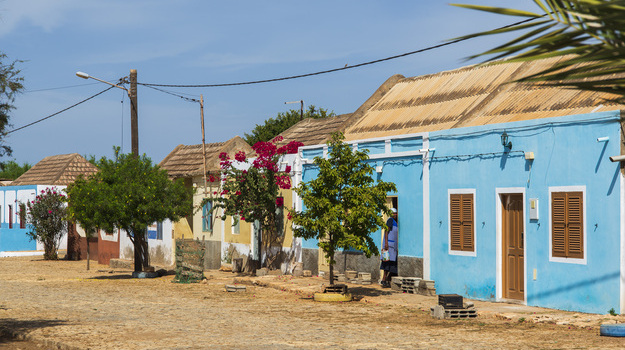 Morrinho Village
Morrinho Village
Santiago Island: the beating heart of Cabo Verde
Santiago, the largest island in the archipelago, is the historical and cultural epicentre of Cabo Verde. Here, traditions, markets, the colonial past and nature coexist, providing an authentic and rich experience for any visitor.
Every corner of the island reveals a facet of history and the island is a true treasure for the curious who wish to absorb the Cape Verdean spirit in all its genuineness.
Things to do on the island:
Beaches and Natural Pools:
Tarrafal Bay and Beach:
Located in the north of the island, Tarrafal Bay is a paradisiacal refuge of golden sand and calm waters, protected by mountains that block the strongest winds.
The crystal clear, calm waters make it the ideal place to relax, swim and do water sports.
Additionally, the small village surrounding the beach offers a spontaneous glimpse into Cape Verdean hospitality and local life.
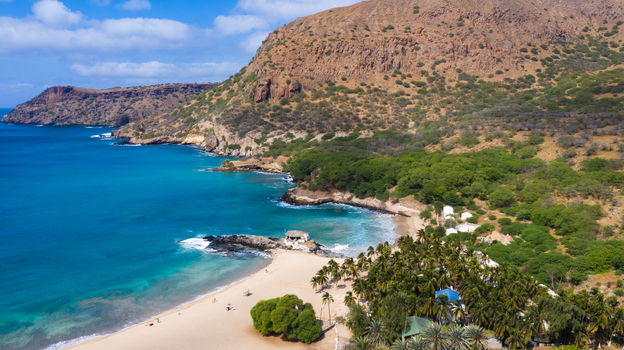 Tarrafal Beach with its vibrant blue sea
Tarrafal Beach with its vibrant blue sea
Gamboa Beach:
Located in the capital (Praia), Gamboa is a popular beach among residents and is the scene of parties and celebrations, such as the Gamboa Festival, one of the most important musical events in the country.
The calm sea and proximity to the city center make Gamboa an excellent place for a quick swim and a moment of relaxation.
Piscinas Naturais de Cuba: Cuba's Natural Pools:
In the Achada Fazenda region, these natural pools are one of the most popular places for lovers of nature and tranquility.
Formed by volcanic rocks, the pools offer a unique experience in crystal clear waters, surrounded by rock formations that isolate the place, creating a relaxing and unique environment.
Nature and Mountains:
Serra da Malagueta Natural Park:
With trails that wind through lush vegetation and gently contoured mountains, hikes in this park reveal stunning views of verdant valleys and mountain peaks.
The biodiversity of Serra da Malagueta is remarkable, with several endemic species of plants and birds.
The trails are ideal for both beginners and more experienced hikers and reveal an in-depth look at the natural beauty of Santiago.
Jardim Botânico de São Jorge dos Órgãos:
This garden is a true oasis of green and exotic Cape Verdean life. Situated in a mountainous area, the garden conveys a sensorial experience among medicinal plants, fruit trees and rare species.
It is a perfect place to admire the rich Cape Verdean vegetation and go for a walk.
Poilão:
In Ribeira de Boa Entrada, you will find one of the island's most emblematic landmarks, the Poilão, a monumental tree, considered sacred to the local inhabitants.
Located close to the center of Assomada, the tree has an impressive grandeur, both for its size and longevity.
It is a meeting and celebration point, surrounded by legends and meanings that reinforce the deep connection of the people of Santiago with nature and ancestry.
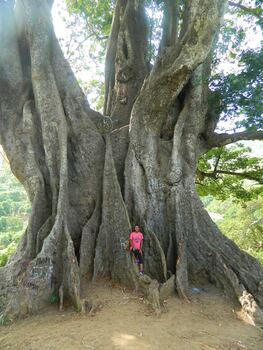 The Poilão
The Poilão
Photo - Facebook photo of Sustainable Tourism in Cabo Verde
Cities and Towns:
Cidade Velha:
Cidade Velha is the cradle of Cape Verdean history and a UNESCO World Heritage Site.
Founded in 1462, the Old City preserves colonial relics such as the famous Pillory, a symbol of the slavery period, and the oldest church in the sub-Saharan region.
The ruins and monuments tell the story of the first encounters between Europe and Africa.
A walk along Rua da Banana is a dive into the past that takes us to the beginnings of the archipelago.
Tarrafal:
In addition to the famous bay and beach, Tarrafal houses the old Concentration Camp, a place of great historical importance, especially during the colonial period.
The camp was used to incarcerate political prisoners and today houses a museum that commemorates the struggle for freedom and the years of repression.
Tarrafal is, therefore, a place of reflection and tribute to Cape Verdean resistance.
Praia:
The capital of Cabo Verde is a dynamic and cosmopolitan city, which shows tradition and modernity in harmony.
The Planalto area, the historic center of the city, offers colorful colonial buildings, lively markets such as Mercado Municipal, and a typical Cape Verdean atmosphere.
At night, Praia reveals a vibrant facet with bars, restaurants and live music, to discover the rich gastronomy and the engaging rhythm of mornas and coladeiras.
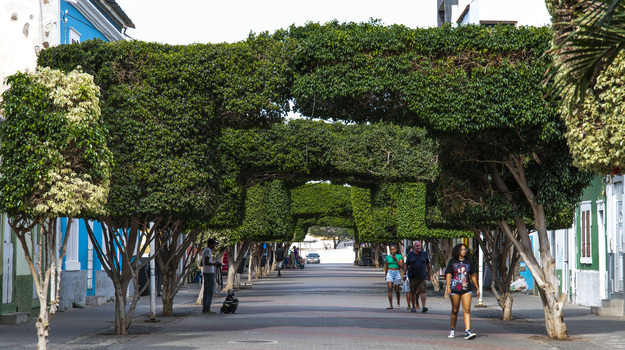 Rua 5 de Julho, in the historic center of Praia
Rua 5 de Julho, in the historic center of Praia
Fogo Island: the resilient land of the volcano
With an active volcano, Fogo Island is a land of adventure and dramatic landscapes.
Pico do Fogo is the heart of the island, a magnetic presence that attracts visitors from all over the world.
Along the slopes of the Fogo Volcano, one of the 7 Natural Wonders of the island and also of Cabo Verde, small communities demonstrate unique resilience, such as Chã das Caldeiras.
Fogo is also home to internationally awarded wine, which grows in the most extreme conditions, on the slopes of the volcano's edge.
Things to do on the island:
Beaches and Natural Pools:
Salinas de São Jorge:
The São Jorge Salinas form fascinating natural pools, surrounded by volcanic landscapes that remind us of the island's origins.
The clear water and unique environment make it the perfect place for relaxing baths. A true escape for those who want an experience in harmony with nature and away from the hustle and bustle.
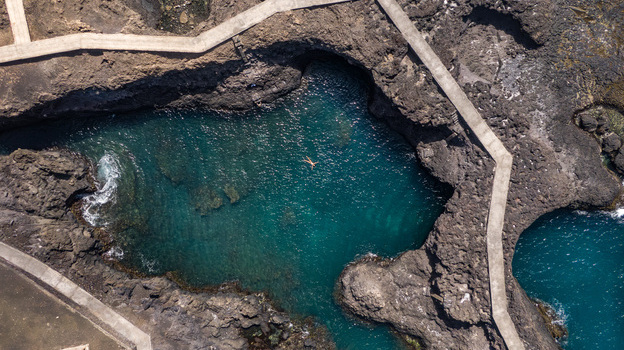 Aerial view of the Salinas de São Jorge
Aerial view of the Salinas de São Jorge
São Filipe Beach:
São Filipe beach, with its characteristic black sand, offers a unique experience.
The beach is quiet and allows you to see the colonial village of the same name in the background. It's a good place to relax after visiting the city.
Mosteiros Waterfront:
On the edge of Mosteiros, in the north of the island, the landscapes surprise with bays and cliffs that offer a spectacular view of the ocean.
The small bay in the area is perfect for a refreshing swim while enjoying the scenery.
Nature and Mountains:
Pico do Fogo:
Climbing Pico do Fogo is one of the most exciting experiences you can have in Cabo Verde. Exciting and demanding.
The route, which leads to the volcano's crater, is full of panoramic views of the island and the Atlantic Ocean.
The climb is challenging, but the impressive volcanic landscape and the feeling of being on top of the highest volcano in the archipelago make every step worth it. An experience in which it is possible to absorb all the energy of Fire.
Take the opportunity to visit the Fogo Natural Park to get to know the region better.
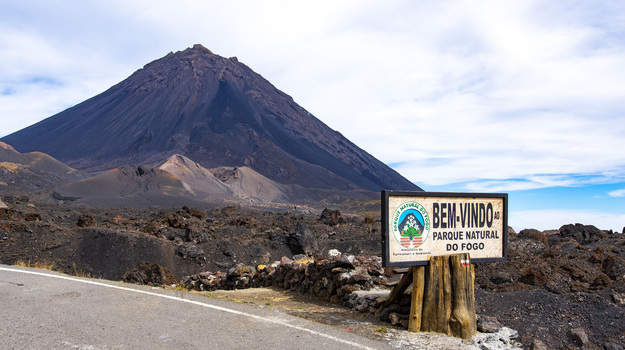 Entrance to the Fogo Natural Park, with Pico do Fogo in the background
Entrance to the Fogo Natural Park, with Pico do Fogo in the background
Bordeira (Santa Catarina):
The Bordeira is a line of abrupt cliffs that rise on the edge of the volcano's caldera, creating a type of natural wall that surrounds the Chã das Caldeiras region.
From the top of Bordeira, visitors can observe a panoramic view of the entire volcanic caldera, including Pico do Fogo.
For adventure lovers, the trails that go up to Bordeira are full of beauty.
Monte Velha:
The forest perimeter of Monte Velha is the largest on the island and one of the largest in Cabo Verde.
The vegetation is predominantly eucalyptus trees, and the area is a refreshing contrast to the island's arid setting.
One of the highlights of Monte Velha is the “Casa do Presidente”, a historic building that hosted political figures in the 1980s.
The area is ideal for walks and picnics.
Cities and Towns:
São Filipe:
The city of São Filipe, capital of Fogo, is charming and full of history.
The stone streets, colorful houses and colonial buildings transport visitors to the past.
São Filipe is one of the best places to learn about local culture, try Fogo's cuisine and visit the craft shops.
The city's viewpoint offers a panoramic view of the island and the volcano.
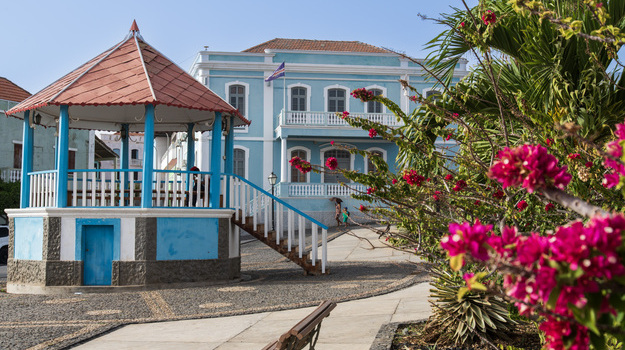 Historic center of São Filipe
Historic center of São Filipe
Cova Figueira:
Cova Figueira is a picturesque village situated in a mountainous area with a stunning view of the volcano.
Known for its plantations, the village is an excellent spot for those who want to get to know the more rural side of the island, with its agricultural traditions and the warm hospitality of the residents who invite you to taste fresh fruits and local products.
Chã das Caldeiras:
It’s impossible not to fall in love with Chã das Caldeiras. For his resilience and the courage of his people.
Located at the foot of the volcano, with vineyards and plantations that flourish in the volcanic soil, the village is a testament to resilience.
With wisdom and courage, the residents adapted to the challenging terrain and today produce wines and spirits that carry the unmistakable flavor of Fogo Island.
The landscape of Chã das Caldeiras is almost surreal, with black fields, volcanic rocks and small villages.
Ilha da Brava: the island of flowers and mountains
Imagine a place where the silence is scented with flowers and the mountains whisper stories of a forgotten time. That's the charm of Brava, the smallest and most serene of Cape Verde's inhabited islands.
A natural corner where beauty grows without haste, surrounded by a mild climate and lush vegetation, which embraces every hill, every stone, every trail.
Things to do on the island:
Beaches and Natural Pools:
Fajã d’Água:
There is an almost mythical charm to Fajã d’Água, a picturesque bay embraced by imposing mountains.
The calm waters reflect the sky like a mirror, and here there is the famous Poça Preta, a natural pool of clear waters heated by the volcanic earth, which invites you to take an invigorating dip.
It’s the kind of place that redefines the word “refuge”.
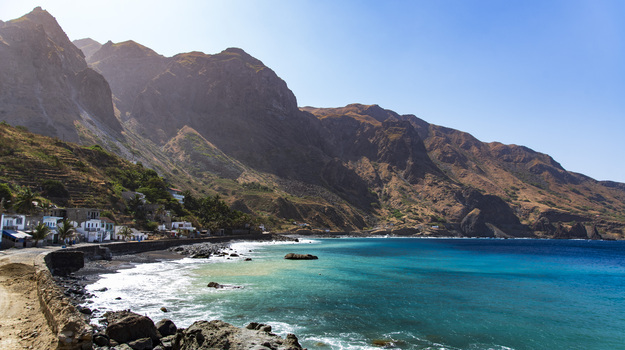 View of Fajã d’Água
View of Fajã d’Água
Ferreiros Beach:
A small stone beach, only about 500 meters long, perfect for those who dive and want to discover marine biodiversity.
Its clear waters are home to an underwater spectacle of life and colors, ideal for those who want to explore the sea.
Furna Port and Bay:
In the northeast of the island, Furna Bay is the island's main port, through which visitors arrive.
All around it, the fishing village of Furna exudes an authenticity that transports the visitor to Brava's traditional way of life.
Nature and Mountains:
Monte Fontainhas:
The highest point on the island reveals panoramic views that stretch as far as the ocean and sky touch.
The trail to the summit of Monte Fontainhas is an invitation to adventure, each step reveals a landscape that changes and surprises, until, at the top, the reward is one of the most spectacular views of Brava.
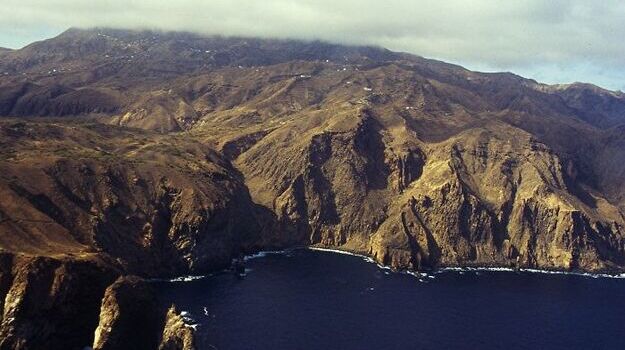 Monte Fontaínhas
Monte Fontaínhas
Source - By Holger Reineccius via wikipedia
Porto Natural do Ancião Bay:
Surrounded by imposing mountains and cliffs that plunge into the Atlantic, this bay is a natural jewel that combines the serenity of the ocean and the strength of the rocky landscape.
The bay has a natural harbor and its crystal clear waters are impressive.
Nossa Senhora do Monte Viewpoint:
At the top of the mountain, the viewpoint of Nossa Senhora do Monte reveals a view beyond what words can describe.
This is the point where the coast and the capital, Nova Sintra, reveal themselves. Here, everything seems to take on a special magic, as if time multiplied to offer the visitor a moment of pure contemplation.
Cities and Towns:
Nova Sintra:
The capital of Brava is a city that breathes history and is considered by many to be the most beautiful in Cabo Verde.
The houses have colonial architecture and the streets are full of flowers. Nova Sintra was named after the Portuguese Sontra, due to its mild climate.
You can visit Eugénio Tavares Square and House, which pay homage to the poet and journalist, called by many the “Camões of Cabo Verde”, whose contribution to the country's culture is undeniable.
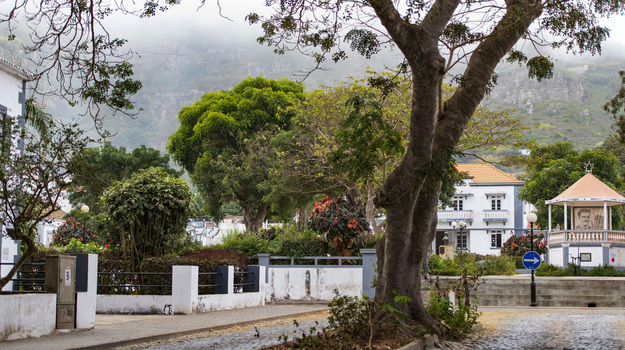 Center of Nova Sintra
Center of Nova Sintra
Cova Rodela:
Cova Rodela, an agricultural settlement, is famous both for its dragon tree and for its crops and the generosity of the people.
In Cova Rodela, visitors discover the essence of the island: hospitality, simplicity and a landscape shaped by the work of the hands that cultivate the land.
It is a place to discover the flavors and aromas of the island, and to see how the heart of Brava beats in the green fields.
Lomba Tantum:
A quiet fishing village, Lomba Tantum glimpses the simple and authentic life of Brava.
Interacting with the local community, learning about traditions and hearing the stories of fishermen are experiences that enrich and reveal the cultural richness of the island.
At Lomba Tantum, life follows a peaceful and welcoming rhythm and each visitor is welcomed as part of the family.
Santa Luzia: the uninhabited island with wild charm
This uninhabited island holds a special place in the heart of Cape Verde. Located between São Vicente and São Nicolau, Santa Luzia is an untouched paradise, an ecological sanctuary with wild beauty.
With around 34km2, this Partial Natural Reserve features hills, rocky plains and beaches. Here, it was once the birthplace of seabirds such as Shearwaters and Pedreirinhos.
This ecological sanctuary, accessible only by boat and with authorization from the State Department of the Environment, is a haven of purity that demands respect and admiration.
The island is one of the most important sea turtle nesting sites, with protected areas where dedicated volunteers ensure the safety of both females and their young. During the nesting season, access to the island is strictly regulated, given the need to preserve this fragile habitat.
Santa Luzia is also a paradise for birdwatching enthusiasts. It is possible to observe birds such as the shearwater, the blue mason, the reed-tail and even the emblematic dune lark. These species make the island's arid, coastal landscapes a living spectacle of sound and movement.
In the archipelago, this island is more than a destination; It is a commitment to sustainability and preservation.
To explore this natural treasure, you should contact tour operators who organize guided tours in advance for responsible access to one of Cape Verde's greatest natural heritage.
The Cabo Verde Islands await you
Each of Cape Verde's islands offers a part of the archipelago's diversity and richness.
Whether on beaches, mountains or cities, the country is an invitation to travelers seeking both adventure and tranquility.
Pack your bags and explore the islands of Cabo Verde and let yourself be enchanted by their natural beauty and vibrant culture.





